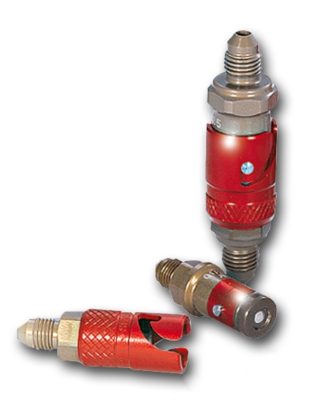Do you know the difference between quick-disconnect and drybreak connectors? The designation can be pretty important.
The days of having to screw and unscrew something every time you replaced a part on a race car are, thankfully, behind us. Modern plumbing, much of it coming courtesy of the aerospace industry, has made connections much easier, allowing for much simpler parts swaps. In fact, Doug Syer, the business development manager for Stäubli Corporation, paints a very clear example using endurance sports cars in races such as the 24 Hours of Le Mans.
“They used to pull in, take the brake caliper off, push the pistons back, throw in a new set of brake pads and off they would go again,” Syer explains. “It was time-consuming because you had to take the reservoir off and allow the fluid to get back, and it also gave a good opportunity to burn yourself with the heat of the caliper.
“Now they have a pre-bled caliper and brake pad setup ready to go, and when the pull in for a brake change, all they have to do is pull in and disconnect our SPH, which is a bayonet-style locking system. Put the new, pre-bled caliper on, plug the line in and you have brakes again. It takes seconds instead of minutes now.”
As important as the time is, it’s the connector that makes it possible. A drybreak connector, Syer explains, has a flush face that doesn’t allow any fluid to spill and, more importantly in the case of braking systems, doesn’t allow any air to get into the system.
Contrast that to a quick-disconnect, which “will stop the flow of fluid at both ends, but it’s not a flush face. It has a void, a cavity inside the two connecting parts, and the larger the connector, the bigger that void. It will allow fluid to spill out and, when putting it together, whatever air is in that cavity also gets put into a brake system or hydraulic system. It’s something you can’t use in a brake system. As soon as you introduce air into hydraulic system, it becomes spongy and it just doesn’t work properly with air in it,” he explains.
Quick disconnects are fine for many purposes, such as cooling systems, where loss of fluid or introduction of gas into the system isn’t going to make a difference. It can even be fine for oiling systems, as long as you don’t mind cleaning up drips here and there. But most recommend a daybreak for fuel systems, especially connections located where fuel could spill on exhaust manifolds or other hot engine parts. A fuel test port – Stäubli makes the fuel test port that MAZDASPEED Motorsports Development sells – which is required by several racing sanctioning bodies, is one of those places where a drybreak is recommended.
Another thing to consider, aside from the type of connector, is the type of gasket suitable for the connection. Some seals are not compatible with certain fluids.
“It’s very important to use the proper seal,” Syer says. “Some places claim a Viton seal is adequate for an application; but what we’ve found is we’ve gone to a Kalrez seal, which is much better suited for a high ethanol content, the toluene, the nasty stuff they put in the fuel now. A Viton seal is OK for static; but if the seal moves, if that seal swells at all, then the piston doesn’t come back and seal properly. If you use the wrong seal, it defeats the purpose of what you’re trying to accomplish with the drybreak.”
Using drybreaks and quick disconnects can make working on your race car much easier than working with clamps and screw-on connectors. If you consider the application carefully and use the proper fitting, it will enhance safety as well.


 ACCESSIBILITY
ACCESSIBILITY